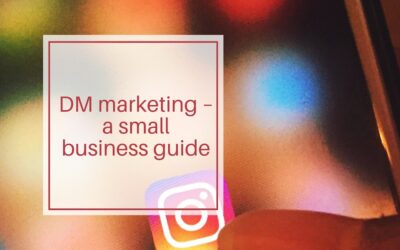SEO – search engine optimisation or, making it easier for your customers to find you. Often used in the context of websites and Google, SEO is now also relevant on Instagram.
Get found by your ideal customers by incorporating keywords and SEO on Instagram into your digital marketing strategy. ‘But isn’t Instagram all about hashtags?’ I hear you ask. Not anymore:
- Instagram now works as a search engine analysing all your content, not just hashtags. Millions of users rely on it to find new products and services, especially Gen Z, who prefer to stay on the platform rather than open a browser to search Google.
- Google itself crawls social media pages and will incorporate them in search results where it deems them the most helpful.
- Keyword research provides insight into how customers search for your business, and their pain points or desires which helps you create the content they want to see.
Luckily, SEO on Instagram doesn’t need to be complicated. We break it down into five simple steps.
1. Research keywords for SEO on Instagram
The most effective keyword research starts by identifying your ideal customer and the search intent you want to rank for. If you sell dog-friendly cheese from a small business in Queanbeyan, for example, ranking for cheese or dog is unlikely, let alone likely to lead to a sale. You want customers who specifically want to purchase not just cheese but dog-friendly cheese.
With your user intent in mind, use keyword research tools to see what phrases people are searching online. Keep it simple (and free) with Google Ads keyword planner, or try the more detailed UberSuggest or SEMrush on a free trial. Remember to limit results to the area you service, as different countries may search different terms. Compile your list of relevant keywords that feel aligned with your business whilst remaining open to potentially unexpected suggestions that make sense. Try for one or two that you use regularly and a number that you can scatter through your content to prove to the search engine (and your audience) that you truly understand your area of expertise.
For example, you might find that dog-friendly treats or dog-friendly dairy rank higher than dog-friendly cheese. With your user intent in mind, you might make them your regular keywords.
2. Optimise your Instagram profile listing
Start with your Instagram handle. It should already include your business name (fix this fast if it does not). To optimise further, you might add the keyword that most precisely explains your product or service.
Eg. @bobbrown might become @bobbrown_comedian
Note: Don’t fall into the trap of using the most searched keyword if it’s not 100% relevant to your business and your ideal customer search intent. Better to use a lower-ranking keyword that matches customer intent than a confusing one, especially in your handle.
Ensure the first line of your about section is a clear and optimised explanation of what you do followed by who and how you help. Using great keywords here will help Instagram understand your expertise, and let your customers know they are in the right place.
Take ours, for example, ‘The Social Nest, Social Media Strategist, Helping you grow your business.’
3. Use your keywords to create Instagram content
Once you know your keywords, use them within your usual marketing strategy. They should flow naturally in captions, match scroll-stopping images, feel consistent, and align with your brand. If you struggle to use them easily and naturally, return to step 1 and start researching again with fresh insight and understanding.
4. Add your hashtags
The role of the humble hashtag may be evolving, but it’s not out of the game just yet. Write your content using well-researched keywords then add hashtags at the end to maximise impact. Hashtags still serve a guiding role allowing users to find and follow subjects of interest.
If you are short on time, start by trialling some of your keywords as hashtags – after all, there will be overlap! But if you can, check with tools like All-hashtag to identify popular and trending hashtags to reach the broadest audience you can.
5. Track, review, and fine-tune
Using SEO on Instagram is like any new approach to social media; to maximise your results you need to track, review, and fine-tune your efforts. Consider the following simple ways to review the impact of your keywords:
- Optimise your content with the same keyword as your handle and about section for a few weeks to see the impact before adding others to the mix.
- Post similar content with different keyword focuses for A/B testing to see which has the greater reach.
- Follow and search for your keywords periodically to what is trending and ensure they still align with user intent.
- Monitor key metrics like click-through, engagement, and conversions to see if there is a pattern to the focus keywords achieving the best results.
- Review your keywords every six months as you would your hashtags and add or remove accordingly.
Still got questions about SEO on Instagram? Make the most of your online real estate and book a call with The Social Nest today.



